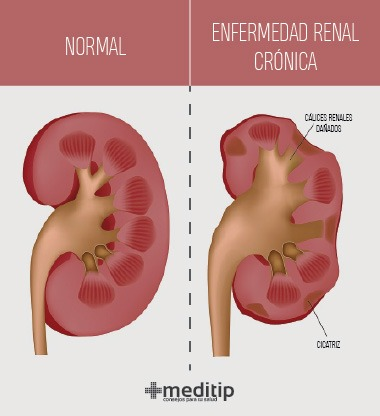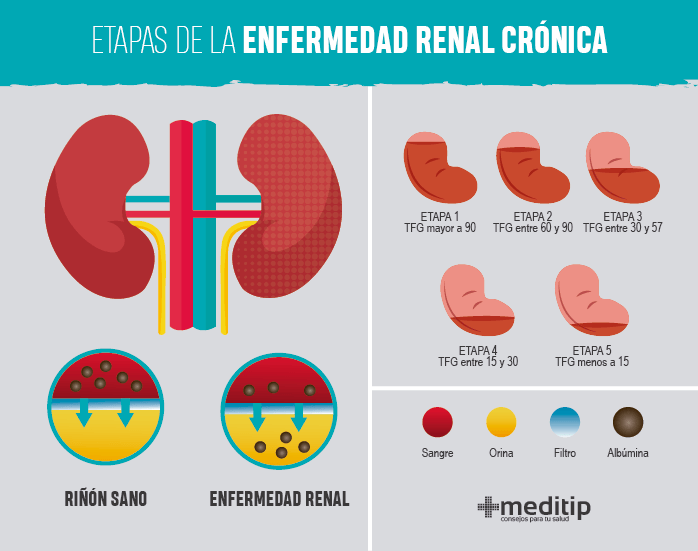

Hoy les comentaré sobre una patología crónica y no transmisible: enfermedad renal crónica.

Today I will comment on a chronic and non-communicable diseases (NCDs): chronic kidney disease.
A cordial greeting to the entire community, a pleasure to greet you, here is your server: @galejandrovv.

¿QUÉ ES LA ENFERMEDAD RENAL CRÓNICA?
¿WHAT IS CHRONIC KIDNEY DISEASE?

Fuente / Source

CAUSAS DE ENFERMEDAD RENAL CRÓNICA
CAUSES OF CHRONIC KIDNEY DISEASE
- Diabetes mellitus.
- Hipertensión arterial.
- Enfermedades autoinmunes.
- Infecciones renales a repetición.
- Obstrucción de las vías urinarias.
- Enfermedades congénitas de riñones y vías urinarias.
- Algunos fármacos: AINES, antibióticos, anticancerígenos, etc.
- Mellitus diabetes.
- Arterial hypertension.
- Autoimmune diseases.
- Recurrent kidney infections.
- Obstruction of the urinary tract.
- Congenital diseases of the kidneys and urinary tract.
- Some drugs: NSAIDs, antibiotics, anticancer drugs, etc.

MANIFESTACONES CLÍNICAS
CLINICAL MANIFESTATIONS
Cuando el filtrado glomerular cae por debajo del 15%, es cuando se inician los signos y síntomas del síndrome urémico (por aumento de urea en la sangre), pudiendo aparecer: hipertensión arterial, anorexia, náuseas, vómitos, anemia, enfefalopatía urémica, deformidades óseas, prurito (picazón), impotencia sexual en hombres, alteraciones del ciclo menstrual en mujeres, edema en extremidades inferiores, aumento de urea y creatinina en sangre, etc.
When the glomerular filtration falls below 15%, it is when the signs and symptoms of uremic syndrome begin (due to increased urea in the blood), and may appear: arterial hypertension, anorexia, nausea, vomiting, anemia, uremic encephalopathy, deformities bone, pruritus (itching), sexual impotence in men, alterations of the menstrual cycle in women, edema in the lower limbs, increased blood urea and creatinine, etc.

Fuente / Source

DIAGNÓSTICO
DIAGNOSIS
- Aumento de urea por encima de 40 mg/dl.
- Aumento de creatinina por encima de 1.2 mg/dl.
- Presencia de sangre, proteína y microcristales en el examen de orina.
- Alteración del tamaño y configuración del riñón, visto a través de ecografía.
- Increased urea above 40 mg/dl.
- Increased creatinine above 1.2 mg/dl.
- Presence of blood, protein and microcrystals in the urine test.
- Alteration of the size and configuration of the kidney, seen through ultrasound.

TRATAMIENTO
TREATMENT
El tratamiento sustitutivo consiste en hemodiálisis o diálisis peritoneal, para eliminar las toxinas del organismo. El tratamiento definitivo es el transplante renal, pero, la gran problemática de éste es que, resulta bastante difícil lograr la total compatibilidad entre el donante y el receptor.
Replacement treatment consists of hemodialysis or peritoneal dialysis, to eliminate toxins from the body. The definitive treatment is renal transplantation, but the great problem with this is that it is quite difficult to achieve total compatibility between the donor and the recipient.


Texto traducido en XTranslate
Separadores creados en Gravit Designer
Vectores descargados de Flaticon
Banner's creados en Canva
Translated text with the extension XTranslate
Separators created in Gravit Designer
Vectors downloaded from Flaticon
Banner's created in Canva

PRIMUM NON NOCERE









The rewards earned on this comment will go directly to the person sharing the post on Twitter as long as they are registered with @poshtoken. Sign up at https://hiveposh.com.
Su post ha sido valorado por @ramonycajal
Congratulations @galejandrovv! You have completed the following achievement on the Hive blockchain and have been rewarded with new badge(s):
Your next target is to reach 2750 upvotes.
You can view your badges on your board and compare yourself to others in the Ranking
If you no longer want to receive notifications, reply to this comment with the word
STOPCheck out the last post from @hivebuzz:
Support the HiveBuzz project. Vote for our proposal!
Thanks a lot for sharing this wonderful piece.
I always knew that NSAIDS is one of the risk factors but then patients don't stop even after telling them about the effects because of maybe the pain they are having.
It is always good to prevent the Disease especially by adequate water intake.
Thanks for this wonderful piece